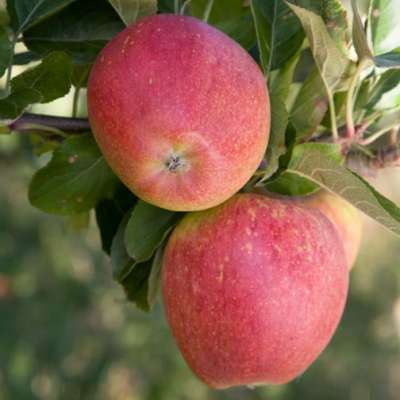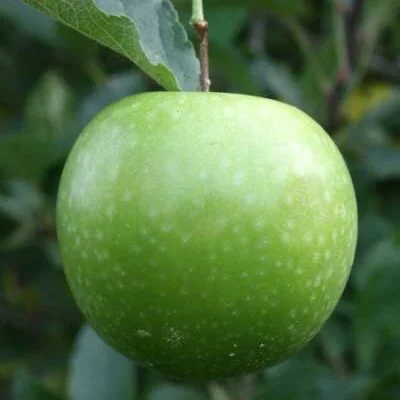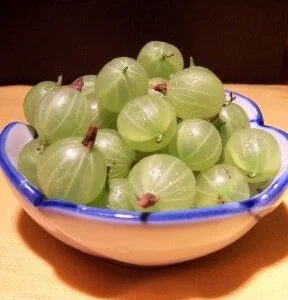Your basket is currently empty!
- Practicalities
- Siting
- The Path Beneath
- What to Grow
- Other Fruits
- Hardy Exotics
- Other Tips to Remember
Pioneered by Chris Bowers several years ago, the fruiting arch makes a wonderfully attractive, practical and productive addition to any garden. A very wide range of fruits can be grown in a manner that requires little actual ground space, because the fruits concerned are trained upwards. As the system matures and the trees and plants grow together it will become more like a wonderful green ‘tunnel’ with the ripening and maturing fruits hanging down in tempting array!
Practicalities
What type of arch to use or utlilise? It doesn’t really matter what materials are used for the arch but the more durable they are then the better so as to avoid maintenance or replacement work later, when the plants and trees are becoming productive. Wrought iron is of course the ideal, but expensive. Pressure treated timber is fine, as long as it has been treated. You can also but ready-made resin coated plastic rose arches and the like which are quite cost effective.
Spacing The height of the support system should be no less than 6′ and, ideally 7-8′ in height. The arches themselves should be between 4 and 6’apart, to allow for sunlight to penetrate around the plants and trees. In width you would need to allow at least 5′ to allow for comfortable walking. Perhaps these dimensions do not seem very big to you but it should be remembered that, as described later, you will be using intensive growing methods whereby whatever types of fruit you incorporate, they will not be growing wildly in all directions!
Siting
Any aspect will do, but the sunnier the better. If you need to site your arch or fruiting walkway in a shady spot then you can do and make sure you choose those fruits more suited to site – basically cooking apples, rubus species [Blackberries[Loganberry/JapaneseWineberry]
The Path Beneath
There is a wide range of paving and path materials you can use from traditional stone paving, bark chippins, turf, or shingle. Which you use is down to personal use and the budget available – all are suitable. If forced to choice then grass is the most aesthetically pleasing but of course it does require upkeep.
What to Grow
The number one choice would have to be a Chris Bowers supercolumn tree (further information on our supercolumns can be found here). This is a fruit tree with slender columnar growth that is easy to and train and needs little pruning. It can encompass a very wide range of fruit trees and would be ideal trained over a 6′ arch. Apples – both cooking and dessert, Pears, Plums, Gages and Cherries can all be grown in this way. The trees require one annual pruning which consists of trimming back any side laterals to around 2″ – that is all. The trees will naturally fruit top to bottom and, because they receive more sunlight than a ‘normal’ tree the results will be very impressive – more highly coloured and sweeter too.
The varieties should really be left to your own personal taste but the following are some recommendations of particularly good varieties.
Apples
Red Falstaff, Greensleeves, Limelight, Red Windsor, Redsleeves, Winter Gem, Discovery, Sunrise, Herefordshire Russet and Spartan.
Cooking varieties: Howgate Wonder and Bountiful. Bramley is also good with this system.
Pears
Pears are ideal grown in this way because they appreciate the extra warmth and sunshine more than any other top fruit. Varieties like Doyenne du Comice and Precoce de Trevoux which can often be shy, will perform very well. Concorde, Merton Pride, Invincible and Beth are all extra-reliable.
Plums
Jubilee is the number one choice these days, Victoria remains the popular choice and Marjories Seedling is a very worthy addition which ripens later.
Cherries
Look no further than Summer Sun, Stella and Sunburst. 3 large black sweet cherries full of juice & flavour.
If your arch is going to be a little taller – say up to 8′ – then you should consider the classic cordon grown fruit tree as these will be able to take advantage of the extra height. The range of fruits you can grow is a little more restricted – Apples [Cooking and Dessert] Pears and Plums. But within that group you can grow all varieties. The side laterals are also pruned just once a year but a little longer, around 3″ in length. Cordons can crop very heavily and produce durable, reliable trees.
Other Fruits
The Rubus family contains a very wide range of climbing fruiting plants that are ideal for the fruiting arch or tunnel. The Blackberry is the most famous example and an ideal choice – just remember to restrict your choice to thornless examples since no-one will be keen on using this walkway if your clothes are being ripped to shreds by thorns! Good thorn free Blackberry varieties include Merton Thornless, Loch Tay, Smooth stem, Adrienne and Chester. Perhaps the very best variety for use here is the Oregon Thornless because it such an attractive plant with finely divided ‘parsley leaved’ foliage and good autumn colour. It’s clusters of shiny black well flavoured fruits are borne in abundance. Avoid the compact strains of Blackberry such as Loch Ness and Waldo because they won’t have enough vigour to climb up the posts.
There are also a number of interesting Rubus hybrids – known as Hybrid Berries, a number of which make excellent climbing plants. Number one here has to be the Boysenberry which is like a large and lusciously flavour ‘king’ Blackberry with an intense taste and thorn free stems. It makes amazingly flavoursome jams. The Japanese Wineberry [Rubus phoeneciolasus] is also outstandingly attractive with its main stems all covered in a rich red fuzz. It has deeply veined limey green leaves and the small scarlet berries are said to be best served as a treat, sprinkled with a little red wine! The Tayberry is another Rubus member related to the Blackberry, but much finer. Its very large loganberry type fruits hang in cascading curtains and are very juicy and richly flavoured, ideal for dessert or jam making, freezing, pies etc. It is astonishingly free fruiting and a must-have. The variety ‘Buckingham’ is new and thorn free, the most appropriately used here. The above should all be trained and cultivated as for the normal instructions for Blackberries contained in our cultural guide, which ca n easily be adapted so that the plants are tied in to a single post and arch system.
Hardy Exotics
If the aspect is a sunny one why not try a Chinese Gooseberry, or Kiwi vine? They triumph with rather large felted green heart shaped leaves and bristly maroon stems. The sight of those drooping clusters of fascinating fruits will have garden visitors in raptures! The vines themselves are actually reliably frost hardy in most areas; the fruits should be harvested in October and left to ripen on a sunny windowsill. Plant two, one each side, a male and female like Hayward and Atlas. The self fertile variety ‘Jenny’ is better suited to a conservatory or warm sunny wall unless you live in a favoured locale.
And lastly Grapes – anabsolutely ideal choice, full of ornamental grandeur and tempting large bunches of sweet fruits – what could be more ideal for your fruiting arch or tunnel? Grapes are quite happy being pruned any which way so they do not need to get out of hand. Regular pruning actually encourages more fruit. Our range now includes an ever increasing selection of very good varieties. These are some highlights from the best outdoor varieties: Boscoop Glory, Regent, Muller Thurgau (an excellent wine making grape), Theresa, Phoenix,Early van de Laan, Brandt (an old classic which has stunning Autumn leaf colour) and Dorndfelder. Any of these varieties will be guaranteed to perform well.
Some Other Tips to Remember
Do harvest the fruits often and keep up with it; over-ripe fruits falling to the floor where you will be walking will spoil the effect. And a certain amount of over-exuberant growth will be attractive, but do make sure they plants and trees are kept in check and not allowed to swap the structure completely.
Underplanting
You can add out of season interest with the use of spring flowering bulbs such as Wood Anemones, Daffodils, Miniature Narcissi, Grape Hyacinths and the like. You can also use smaller woodland type plants such as Viola odorata, certain smaller hardyGeraniums and Trilliums. And lastly, why not underplant with wild woodland and alpine strawberries so that they can carpet the understorey, studding the ground with their aromatic little scarlet berries.








